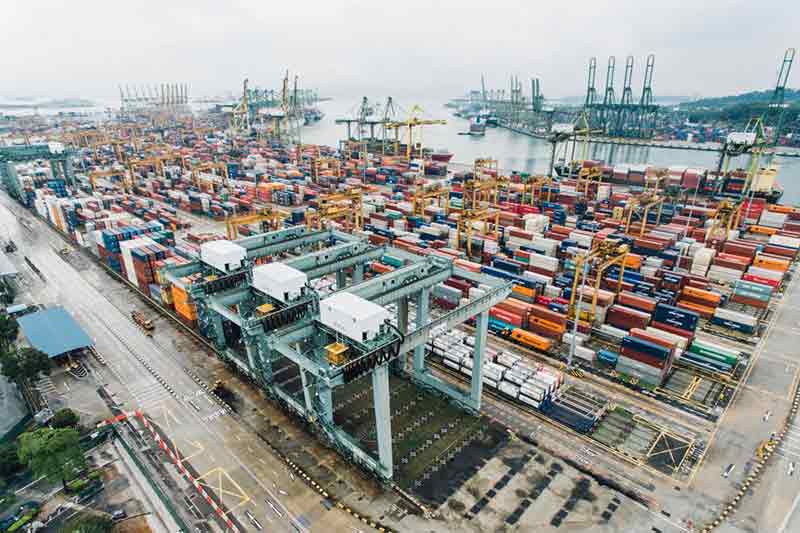
The Maritime and Port Authority of Singapore (MPA) has unveiled
four broad strategies to drive Singapore’s next phase of growth as a Global
Maritime Hub for Connectivity, Innovation and Talent.
MPA will take steps to strengthen the connectivity and
inter-linkages of Singapore’s maritime cluster, build a vibrant innovation
ecosystem and develop a future-ready and skilled maritime workforce. MPA will
also enhance and top up the Maritime Cluster Fund (MCF
[1]) by S$100 million in support of the
vision.
Capturing physical
and non-physical flows
To boost physical connectivity, MPA will continue to work
with PSA International Pte Ltd (PSA) to
invest in port capacity and infrastructure to meet the industry’s long-term
needs. Pasir Panjang Terminal Phases 3 and 4 will be fully operational by the
first quarter of 2018 , bringing the total port capacity to 50 million
twenty-foot equivalent units.
In addition, reclamation works for the first
phase of Tuas Terminal are also progressing well.
Concurrently, PSA is testing out its new automated terminal
operation systems involving automated guided vehicles, yard and quay cranes,
with the view of deploying such systems at the future Tuas Terminal.
To boost non-physical connectivity, MPA will continue to
expand the range of available maritime services to increase Singapore’s
attractiveness as a maritime hub.
MPA is encouraging existing players to set up new business
activities and it will also promote the growth of non-traditional players such
as maritime technology enterprises like Alpha
Ori and Metcore. Alpha Ori is a
B2B Technology company operating in IoT (Internet of Things), ShipERP
(Enterprise Resource planning) and Big DATA science, while Metcore is a
maritime measurement consultancy, specialising in Mass Flow Metering (MFM) and
also offering inspection services.
To encourage expertise and resource sharing between maritime
companies MPA will co-fund the cost of shared workspaces and services. In the
longer term, MPA, PSA and other government agencies will experiment with
concepts such as inter-modal (the movement of cargo from origin to destination
by several modes of transport where each mode has a different transport
provider or entity responsible) logistics and explore the setting up of a port
and logistics cluster at Tuas, which could spur the development of more
efficient systems for supply chain management.
Leveraging
digitalisation and automation
MPA will launch the Maritime Transformation Programme (MTP)
and set up the Singapore Maritime Data Hub (SG-MDH) to build an enabling
ecosystem that fosters innovation and R&D in the maritime sector.
The MTP will be rolled out over the next few months to build
new capabilities and capture new growth areas for the maritime industry. In
collaboration with National Research Foundation (NRF), institutes of higher
learning (IHLs), research institutes and industry, the MTP will deepen
Singapore’s maritime R&D capabilities in four focus areas:
- Efficient and intelligent world class next generation port;
- Smart autonomous vessel and maritime operations;
- Strategic sea space and maritime traffic management; and
- Effective maritime safety and security.
Funding will be provided to industry partners to
co-contribute to develop new industry capabilities and technologies that have
high potential for industry application.
The SG-MDH will be established as a one-stop data
repository with a centralised application programming interface gateway and
data management capabilities. SG-MDH is expected to enable the development and
test-bedding of innovative digital apps and services for the maritime industry.
The data repository will also serve as a collaborative
platform for technology companies, startups and maritime stakeholders to
co-develop innovative data-driven maritime solutions, support projects under
the MPA
Living Lab and enhance connectivity among key stakeholders in the maritime
logistics ecosystem.
The SG-MDH will provide access to MPA’s port and ship-related
data such as vessel information, vessel arrival and departure time and vessel
position and movement by the third quarter of 2018.
MPA will work with stakeholders such as classification
societies and maritime companies to make their public data available via the
SG-MDH, and will also look to integrate the SG-MDH with the National
Trade Platform and other industry-wide and government systems.
Skill development
MPA will continue to invest in the development of the
maritime workforce. MPA will roll out a new Global Talent Programme (GTP) by
2019 to groom a pipeline of local maritime talent for future leadership and
management positions.
MPA will also co-fund 70 per cent of eligible expenses
incurred by companies which are prepared to commit to training local talent
through structured rotations and overseas attachments. MPA aims to partner up
to 20 maritime companies with a strong focus on human capital development under
GTP over the next seven years.
Additional S$100
million for Maritime Cluster Fund
There are three key components under MCF. The MCF-Manpower
Development co-funds maritime companies in the development of manpower,
training initiatives and capabilities.
The MCF-Business Development supports eligible expenses incurred in the
initial development of new maritime companies and organisations setting up in
Singapore, or existing maritime companies and organisations expanding into new
lines of maritime businesses. The
MCF-Productivity supports initiatives by the maritime industry that will lead
to productivity gains.
To catalyse innovative concepts and forge collaborations
amongst maritime players, MCF will now be used to co-fund proofs of concept
relating to the conceptualisation of new products or services.
MPA will top up the MCF by $100 million to implement its
plans under the Next
Generation Port 2030, the International
Maritime Centre 2030 and the Sea
Transport Industry Transformation Map. The MCF is expected to support about
30 new projects, and benefit around 5,000 people annually.
















